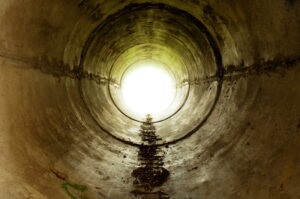Sewer systems go back to ancient times: they’re a necessary improvement that allowed cities to thrive in the first place. Today, most of us take the sewer systems that serve our communities for granted, as well as the sewer lines that connect our homes to the sewer system. But if you’ve got an old sewer line made of outdated material, you may find yourself in a bad situation where you need either sewer line repair or replacement right away.
You can depend on us for these services in the Northshore and Northwest Chicagoland area. To help you know when it’s time to schedule an inspection of your sewer line, we’re going to look at the recent history of sewer line materials so you know what “outdated” means in this case.
Clay
The Romans used this material in their massive civic sewer systems. Clay was used well into the 20th century for many homes. Chicago has homes old enough to have clay sewer lines, although they’re less and less common. Clay has some advantages, like durability and the ability to resist root infiltration. However, clay breaks easily with shifting soil and easily cracks with age. If you’ve got a vintage home with a clay sewer line, it’s best to replace it.
Cast Iron
Cast iron sewer lines first became popular in the 19th and early 20th centuries because of their durability and extended lifespans. They didn’t have the problem with cracking that clay lines have. Unfortunately, cast iron is prone to rust and corrosion over time, and specifically in reaction to chemicals in the water—most won’t last more than 50 years. Iron is also heavy and difficult to work with and has limited flexibility, so it’s almost never used for homes today.
Galvanized Steel
Seeking a less expensive and easier metal to work with than cast iron in the mid-20th century, the plumbing industry settled on galvanized steel, i.e. steel dipped in a zinc solution to help it avoid corrosion. Steel sewer lines are as durable as cast iron and cost less to install, but their corrosion-resistance wasn’t perfect. They also have limited service lives as the zinc coating wears away. They also pick up scale build-up that can lead to blockages. We recommend replacing galvanized steel sewer lines.
Copper
Although copper is a metal used since the beginning of civilization, it only emerged as the modern choice for sewer lines around the 1970s, and it’s remained the main type installed ever since. Copper improves on steel and iron with its superior corrosion- and rust-resistance, its lightweight and high durability, and its smooth interior that lowers the risks of clogs. The cost is higher than galvanized steel, but the advantages—particularly the longevity—make up for it.
Schedule Sewer Line Inspection
Even if you have a copper sewer line, you may still need to have it replaced at some point. Chemical exposure leading to formicary corrosion can damage copper and lead to leaks. If you have a copper sewer line installed in the 1970s, we recommend having a professional inspection to check on its condition. Then you’ll know if you need to have it replaced or relined. A relining can give it many more years of life.
For expert plumbing service, installations, or maintenance contact Reliance Plumbing Sewer & Drainage, Inc. Our knowledgeable plumbers serve the North Shore and Northwest Chicago suburbs. Rely on Reliance!

